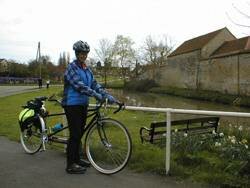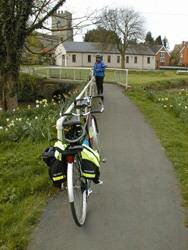|
 Not so long ago tandems almost vanished apart from a few die-hards who wouldn?t let the pastime die. Today there is a renaissance in tandeming as more and more people find joy in the togetherness that tandeming can bring to friends, partners, family or those who previously were unable to cycle. Not so long ago tandems almost vanished apart from a few die-hards who wouldn?t let the pastime die. Today there is a renaissance in tandeming as more and more people find joy in the togetherness that tandeming can bring to friends, partners, family or those who previously were unable to cycle.
What is Tandeming?
Tandeming is simply a term coined for two people riding the same bicycle ?in tandem? i.e. at the same time, the same pace, working together and experiencing the joy and fun of cycling ? together.
To many the pleasure or riding with a loved one and reaching the destination, the top of the hill, together, rather than being many yards behind, can only be appreciated by the many hundreds you see out there dragging up the hill, at the back, trying to keep up!.
However tandeming is not for everyone. It has been said that ?buying a tandem is probably a greater commitment than marriage?, it can certainly test the strongest relationship. Or that to ride a tandem is like making love; ?you both move together, breathe together and groan together?, but I couldn?t say that incase my wife reads this and believes it to be the reason I enjoy riding our tandem together so much!
Tandeming is what you make of it. To some it?s a gentle ride in the country, stopping at their favourite pub for lunch, or at their favourite picnic spot for a summer picnic - our particular favourite. Alternatively it can be a way of you getting fit together.
For the physically disadvantaged, or people with impaired vision, it can be a superb way, or the only way, of getting into the great outdoors and experiencing the smells and tastes that you just can?t get in a car!
Some notable issues regarding your tandem
 Frames Frames
Needless to say, a tandem frame is different to any other with considerable engineering expertise being put into their design over the years. Only buy a well known, quality tandem from a recognized supplier or builder.
Forks
The fork takes a huge amount of punishment, particularly if you have a tandem with disc brakes. Unlike the traditional forks you will find on solo bikes, forks are usually built from specially drawn oversize oval tubes, precisely welded to a specially tapered steerer.
Brakes
Braking systems have dramatically improved over the years and particularly with the advent and use of disc or rim, hydraulic brakes. However you can also easily use and stop a tandem with ?V?brakes and drum brakes.
Wheel rims and spokes
Most wheels built for tandem use 48 spokes. Rims are usually a triple box construction, which simply means that it has three separate hollow areas. The makes a rim very strong.
Hubs also are specially manufactured for tandems to take the extra stresses and strains experience with two people on board. Spokes also are extra strong, usually triple butted which are very strong.
Tandeming - a brief explanation.
First, some tandeming terms. The front rider, or pilot, is in charge of the steering, braking, manoeuvring and the gears. Usually it is the taller and heavier part of the team. The person on the back is called the stoker. The majority of stokers are women due to their size and weight.
 Your first time on a tandem is going to be a wobbly affair; you've got to learn how to balance all over again. It's a new set of bike skills. Use a low gear and keep the momentum up, slow manoeuvring is very difficult. Your first time on a tandem is going to be a wobbly affair; you've got to learn how to balance all over again. It's a new set of bike skills. Use a low gear and keep the momentum up, slow manoeuvring is very difficult.
Before you get on the tandem, work out how you will be stopping at traffic lights and so forth. The stoker, if light, can stay seated, with the pilot having one foot down and keeping the bike upright. Alternatively, both the stoker and the pilot can put their feet down at the same time (and on the same side). This has to be at the call of the pilot - always.
The pilot and stoker have to learn to co-operate. For the pilot it's easy to forget he's riding a tandem (the stoker never forgets, there's a bum in the way!) After a while, the stoker will be able to sense when the gears are about to be changed from the slight slackening off on the chain tension felt through the pedals.
Contrary to popular myth, the stoker cannot have a 'rest' at the back. The stoker, however, can slacken off and let the pilot do all the work and this is a constant gripe from the front. The stoker should only add pressure to the pedals when the pilot does so first. And if the stoker has independent rear brakes she must only use them when specifically asked to do so by the pilot. Braking without telling the pilot is liable to result in an injury to the family jewels of the surprised pilot!
The pilot however has a responsibility to keep the stoker happy. A stoker who is afraid of downhill?s - or mixing it with traffic, will soon vent her feelings with a stiff dig in the ribs. To prevent this, it's far better for the pilot to moderate his riding style, until the stoker has total confidence in his abilities.
|